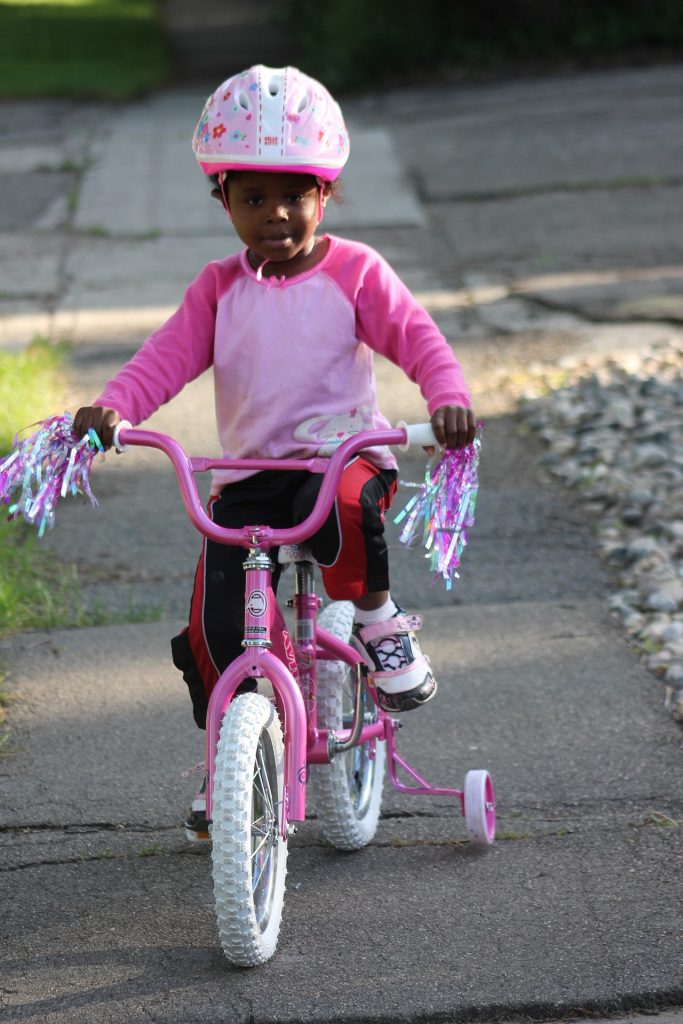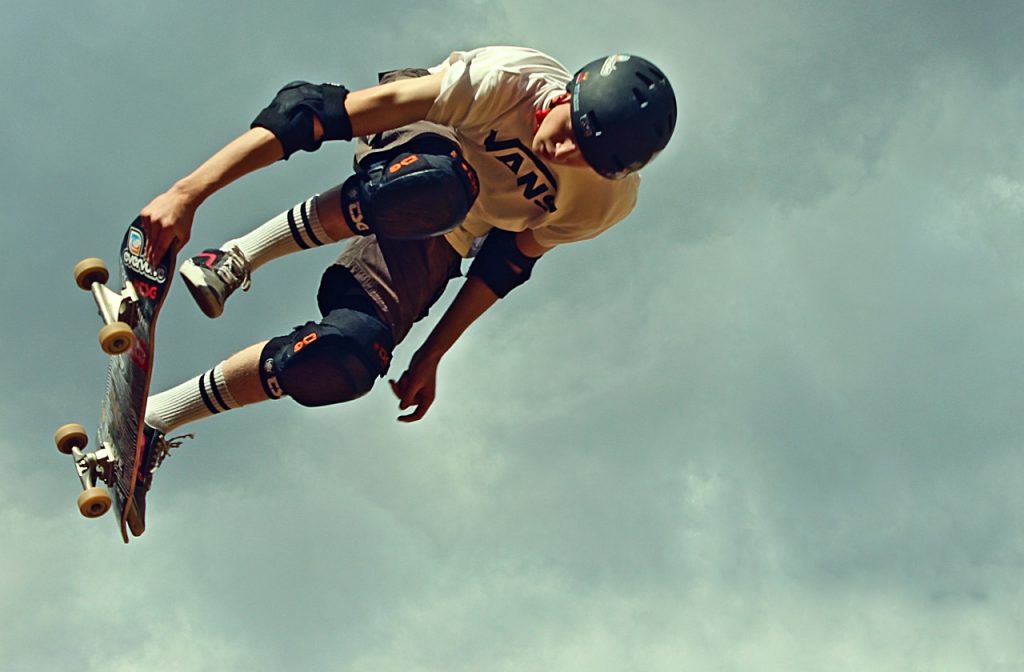Safety comes first for kids and parents who bike, rollerblade, scoot and go skateboarding so we’re sharing tips to keep it fun and protective gear ideas to keep you safe.
When the weather gets warm, adults and kids start to pull out their bikes, scooters, skates and skateboards. Before you let your kids set off to ride to their friend’s houses, or practice their jumps, its a good time to review some safety precautions and road rules together. Also, it’s the perfect time to check the fit of all helmets and the condition of mom’s, dad’s and kid’s bikes, skates and boards.

Road Rules
Consider the following traffic and road rules:
— Stop before riding into traffic from a driveway, sidewalk, parking lot, or other street.
— Look left, right, and left again to check for cars.
— If the road is clear, enter.
— Ride on the far right of the road, with traffic.
— Ride so cars can see you, wearing brightly colored clothes, especially at night.
— Obey all traffic signals and stop signs. Look back and yield to traffic coming from behind before turning left.
— Ride bicycles in single file.
— Be extra cautious with e-bikes if you’re using the motor assist on an incline.
— Look for uneven pavement or other surface problems.
Special Note: Avoid riding your bicycle, scooter, in-line skates, or skateboard during non-daylight hours or during bad weather. If you ride at night, make sure your clothing and equipment have a headlight, flashing taillight, and/or reflectors.
Buying the Right Helmet
Although helmets can cost between $25 and $100, they can save money by possibly preventing a visit to the Emergency Room. When shopping for a helmet, make sure it meets the following requirements:
— The helmet should be approved by the American National Standards Institute (ANSI), the American Society for Testing and Materials (ASTM), the US Consumer Product Safety Commission (CPSC). Approved helmets meet stringent safety standards.
— Helmets come in many sizes and varieties, including many infant sizes.
Some helmets are multi-sport, which can be used for in-line-skating, scooters, skateboarding, bicycling or other wheel sports. Helmets that specifically are called “bicycle helmets” are designed only for that sport.
Proper Helmet Wear
Helmets come with sponge pads that adjust to fit the head. A properly-fitted helmet should meet the following requirements:
— The helmet should fit snug, not moving on the head.
— The front edge of the helmet should be two finger widths above the eyebrows.
— Front and back straps of the helmet should form a V just below the ear.
— Front straps should be vertical and the rear straps should be flat.
— The chin strap should be snug when you open your mouth (one finger should fit between the chin and chin strap when the mouth is closed).
Proper Clothing for Wheeled Sports
When kids take out their wheels, having them put on a helmet and protective gear is key to keeping them safe and sound.
However, it’s a good idea to make sure your family are wearing the right clothing as well:
— Wear high-visibility clothing when you’re cycling at dusk or riding a scooter at night.
— Avoid wearing loose clothing that could get caught in wheels.
— When cycling or skateboarding, wear closed-toe shoes that protect the feet instead of sandals.
— Parents should wear the right clothing and protective gear while using in-line skates, scooters, skateboards and bicycles to set a good example for children.
— To avoid discomfort on long family bike rides, wear anti-chafing shorts like Knix’s Thigh Saver Short to eliminate uncomfortable chafing and excessive perspiration.
Buying the Right Bicycle

It is important to ride a bike that is the right size. In addition, consider the following recommendations for a basic bicycle:
— The bicycle should not be too big or complicated.
— You should be able to place the balls of your feet on the ground when sitting on the seat.
— The bicycle should have a bell or horn.
In-line Skates
Even experienced in-line skaters can crash and sustain injuries. The following recommendations were derived from the National Safety Council and the US Consumer Product Safety Commission (CPSC):
— Always wear protective gear, such as elbow and kneepads, gloves, helmets, and wrist guards.
— Buy durable skates with proper ankle support.
— Always warm up your muscles before skating by skating slowly for five minutes or more.
— Skate with knees slightly bent to maintain balance.
— Practice stopping, which is done by bringing the foot with the heelstop forward until it is level with the toes of the other foot, bend the front knee, and lift the front foot’s toes.
— Always skate on the right side of sidewalks and other paths.
— Pass on the left and warn others that you are passing.
— Avoid skating in the street, especially where there is a lot of traffic.
— Look for uneven pavement or other surface problems.
— Check your skates regularly for wear and tear. Make sure the wheels are tightened.
Skateboards
Skateboards should never be used on surface streets. Even experienced skateboarders can fall, so learning how to fall safely can help reduce the risk of severe injuries. The following are recommendations from the National Safety Council about how to fall correctly:
— When losing your balance, crouch down on the skateboard so your fall is short.
— Try to land on fleshy parts of your body when falling.
— Try to roll as you fall, which prevents your arms from absorbing all the force.
— Try to relax, rather than remaining stiff when falling.
When riding a skateboard, all traffic rules should be obeyed. Other safety precautions to take when skateboarding include the following:
— Wear protective gear such as helmets, padding, and closed-toe and slip-resistant shoes.
— Check the skateboard for wear and tear.
— Only allow one person per skateboard.
— Do not hitch rides from bicycles, cars, or other vehicles.
— Carefully practice tricks in designated skateboarding areas.
Children’s Healthcare of Atlanta, one of the leading pediatric healthcare systems in the country, does extensive research on pediatric health issues and shared these safety tips for active parents and children.
Dear Reader: This page may contain affiliate links which may earn a commission if you click through and make a purchase. Our independent journalism is not influenced by any advertiser or commercial initiative unless it is clearly marked as sponsored content. As travel products change, please be sure to reconfirm all details and stay up to date with current events to ensure a safe and successful trip.